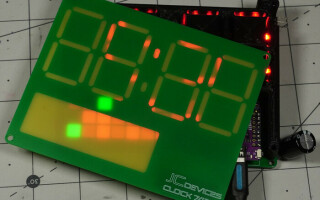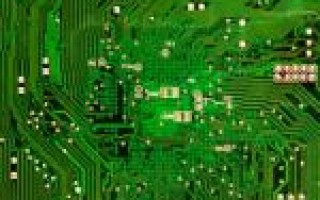Hands-On With the Sparkfun Pro Micro RP2040 - Blog
September 26, 2022The Raspberry Pi RP2040 microcontroller, along with the Pico dev board, and the Pico W (WiFi), have taken the maker world by storm since its original introduction in early 2021. And for good reason, as at $4 for the Pico, $6 for the ‘W, and around a dollar for the chip itself, this 133MHz Arm Cortex-M0+ processor based device is quite an interesting piece of hardware.
Talkie Library Makes Your Arduino Speak Like It’s 1985 - Blog
September 19, 2022Perhaps you remember the early voice synthesizers of the 1980s, which “spoke” in a muffled, marginally intelligible tone. Audio data storage was based on a linear predictive coding (LPC) format, and played back with a voice synthesis processor (VSP).
Fusion 360 Used with KiCad to Produce Unique PCB Diffuser Clock - Blog
August 26, 2022Printed circuit boards are, at their most basic, a way to arrange conductors that travel between solder-mounted parts. At the same time, they’re extremely strong sections of precision-cut and coated fiberglass, that could have structural uses as well.
Hands-On With the Wemos S2 Mini ESP32 Development Board - Blog
August 01, 2022If you’re looking for a great way to get started with the ESP32, the Wemos/LOLIN S2 mini is an excellent option. It comes in a form factor compatible with the ESP8266-based Wemos/LOLIN D1 mini, and the S2 mini can thus work with D2 mini shields. Ground, Vbus, and 3V3 pins are in the same place, though the IO pin numbering is different, so any swaps would certainly require a bit of reprogramming for proper functionality.
Mooltipass BLE Password Authenticator Hands-On Review - Blog
June 30, 2022Today we’re required to use a password for everything from Google, to PlayStation, to Costco, and any number of other websites and services in-between. Using one password for everything is a serious vulnerability, and keeping multiple passwords written down on a notecard, or as a plain text file on your computer are both problematic. Even dedicated online password keepers can be hacked.
Raspberry Pi PWM Fan Speed Control - Blog
May 23, 2022As you probably know, Raspberry Pi single-board computers, especially Pi 4 models, can get quite hot. While passive cooling options are often good enough to avoid overheating and thermal throttling, at some point you’ll need to think about using a cooling fan. The Raspberry Pi’s GPIO pins don’t supply enough current to power even a small fan, but there are several ways to power and control a fan with the Pi.
Experimental Foot Pedal Computer Interface - Blog
May 16, 2022The vast majority of computer control is done by hand, using a keyboard, mouse, or touchscreen, but what about your feet? They’re perfectly capable of tapping out a signal, but generally sit unused when at a computer. In my latest experiment, I set out to see if common spring-loaded foot pedals would work as a computer interface, perhaps for controlling shift, control, or other modifier keys. Short answer: yes, it can work. There are, however, a few complications.
Optimize KiCad Schematic to Facilitate PCB Routing - Blog
May 12, 2022As a PCB design becomes more involved, managing complexity becomes ever more important to the process. Last month’s article about using hierarchical sheets presents an excellent tool for organizing schematics. This is helpful, but at the end of the day these theoretical connections must be transferred to the PCB layout editor for on-screen routing, and ultimately physical manufacturing. To help simplify physical routing, consider how components will be arranged when designing your schematic.
KiCad Hierarchical Sheets for Enhanced Schematics - Blog
April 28, 2022For simple KiCad circuit designs, a sheet with lines going from one component to another is good enough. Add in net labels, and slightly more complicated drawings can be cleaned up nicely. At some point, however, your design may become too large to fit onto a standard sheet. You’re faced with a choice: expand the sheet to cover more area–useful, but often clumsy–or break schematic data up into a series of linked hierarchical sheets.
V-Score Board Separation: Why, How, and Thru-Hole Temporary Connection Trick - Blog
April 27, 2022Some time ago, I wrote an article about panelization basics, mostly focusing on “mouse bites” as the panel separation technique. The other way to separate boards is using a technique called v-scoring. The basics of this technique are shown in the Royal Circuit Solutions video below, which is meant to selectively weaken a PCB for separation at a later point.
Add a QR Code to Your KiCad PCB Design - Blog
April 25, 2022QR codes applied to a printed circuit boards are a great way to reference documentation, a store, or wherever other info is needed for a situation. Adding on to your PCB is quite simple using KiCad, as outlined in this article.
Raspberry Pi 4 Prototyping Enclosure Made From PCBs - Blog
March 22, 2022Printed circuit boards are amazing devices, able to zip electrons from component to component with the greatest of ease. Consider, however, that PCBs are extremely tough, and can be manufactured accurately and inexpensively, to be delivered in a few days.
Printed Circuit Board Panelization Basics - Blog
March 01, 2022When you design a small run of boards for fabrication, it’s extremely likely that the PCB manufacturer will place it in a panel for manufacturing with a number of other designs. This “panelization” allows for boards to be made for low prices, since board space can be efficiently shared between orders.
Kickstarter Fulfillment Workspace and Jigs - Blog
February 25, 2022I’m currently just over halfway through fulfillment on the JC Pro Macro 2 keypad kickstarter project. 178 people pledged with the expectation of a reward, meaning that putting a bit of time and thought into my fulfillment workspace at the beginning was an excellent use of time and resources.
Quick Start: Raspberry Pi GPIO Terminal Interface - Blog
February 17, 2022In this guide, I’ll take you through how to set up a Raspberry Pi from a blank SD card and how to turn on GPIO pins remotely via a terminal. I’m using the MacOS terminal, but other programs, such as PuTTY should work just as well.
PCB Layers Explained - Blog
January 31, 2022The concept of a “printed circuit board” is often thought of as a 2-dimensional entity, whether through EDA software like KiCad, or simply looking at a bare board–that is indeed significantly wider than it is tall. That being said, these boards, as anyone who has worked with them knows, consist of layers.
Do You Need $30 Wire Cutters? Or are $2 Snips OK? - Blog
January 27, 2022There’s a manufacturing parable which tells of a person who can’t sharpen his axe because he’s too busy cutting down trees. The point being that you must invest some time/money into your means of production, even if it’s difficult in the short term.
More Useful 3D Printed Parts - Blog
December 30, 2021Nearly 2 years ago, I wrote an article about my favorite useful designs for 3D-printing. As it just so happens, I recently put out a time-lapse video of my last 2 years of 3D-printing. While there were a few decorative items thrown in, the vast majority of my printing efforts involved useful implements, so I think it’s time for an update!
More KiCad Layout Quick Tips and Techniques - Blog
December 20, 2021When I was first introduced to KiCad, routing traces was described as a bit of an art, something to be learned from experience. I’d say that is true, however, in addition to my first quick tips article, here are some additional–perhaps more strategic–techniques that I can offer to those getting started.
KiCad PCB Layout Quick Tips - Blog
December 10, 2021Throughout the last year-plus, I’ve written a number of articles outlining my experience with KiCad. It’s an incredible open-source EDA package, and what I consider my first and best piece of advice for those getting started is to go ahead and order your first PCB when it seems workable. It may not be perfect, but you’ll certainly be able to improve things on the next run.




















